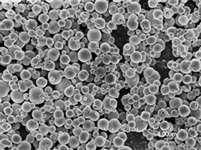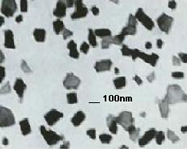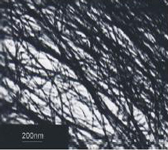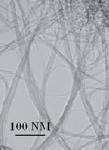MATERIAL SAFETY DATA SHEET
Section 1 Product and Company Information
Trade Name: GOLD COLLOID DISPERSION, 15 NM
Stock Number: GCP1001
Manufacturer/Supplier:
Sun Innovations,Inc.
43241 Osgood RD.
Fremont, CA 94539
Section 2 - Composition/Information on Ingredient
Substance Name CAS #
GOLD COLLOIDAL None
Ingredient Name CAS # Percent
GOLD 7440-57-5 <= 0.02
TRI-SODIUM CITRATE 6858-44-2 <= 0.1
Section 3 - Hazards Identification
HMIS RATING
HEALTH: 2
FLAMMABILITY: 0
REACTIVITY: 0
NFPA RATING
HEALTH: 2
FLAMMABILITY: 0
REACTIVITY: 0
For additional information on toxicity, please refer to Section 11.
______________________________________________________________
Section 4 - First Aid Measures
ORAL EXPOSURE
If swallowed, wash out mouth with water provided person is conscious. Call a physician immediately.
INHALATION EXPOSURE
If inhaled, remove to fresh air. If not breathing give artificial respiration. If breathing is difficult, give oxygen.
DERMAL EXPOSURE
In case of skin contact, flush with copious amounts of water for at least 15 minutes. Remove contaminated clothing and shoes. Call a physician.
EYE EXPOSURE
In case of contact with eyes, flush with copious amounts of water for at least 15 minutes. Assure adequate flushing by separating the eyelids with fingers. Call a physician.
Section 5 - Fire Fighting Measures
FLASH POINT
N/A
AUTOIGNITION TEMP
N/A
FLAMMABILITY
N/A
EXTINGUISHING MEDIA
Suitable: Water spray. Carbon dioxide, dry chemical powder, or appropriate foam.
FIREFIGHTING
Protective Equipment: Wear self-contained breathing apparatus and protective clothing to prevent contact with skin and eyes. Specific Hazard(s): Emits toxic fumes under fire conditions.
______________________________________________________________ Section 6 - Accidental Release Measures
METHODS FOR CLEANING UP
Ventilate area and wash spill site after material pickup is complete. Absorb on sand or vermiculite and place in closed containers for disposal.
Section 7 - Handling and Storage
HANDLING
User Exposure: Avoid inhalation. Avoid contact with eyes, skin, and clothing. Avoid prolonged or repeated exposure.
STORAGE
Suitable: Keep tightly closed.
Store at 2-8 degrees C
Section 8 - Exposure Controls / PPE
ENGINEERING CONTROLS
Safety shower and eye bath. Mechanical exhaust required.
PERSONAL PROTECTIVE EQUIPMENT
Respiratory: Use respirators and components tested and approved under appropriate government standards such as NIOSH (US) or CEN (EU). Where risk assessment shows air-purifying respirators are appropriate use a full-face particle respirator type N100 (US) or type P3 (EN 143) respirator cartridges as a backup to engineering controls. If the respirator is the sole means of protection, use a full-face supplied air respirator.
Hand: Compatible chemical-resistant gloves.
Eye: Chemical safety goggles.
GENERAL HYGIENE MEASURES
Wash thoroughly after handling. Wash contaminated clothing before reuse.
Section 9 - Physical/Chemical Properties
Appearance Physical State: Liquid
Property Value At Temperature or Pressure
pH N/A
BP/BP Range N/A
MP/MP Range N/A
Freezing Point N/A
Vapor Pressure N/A
Vapor Density N/A
Saturated Vapor Conc. N/A
SG/Density N/A
Bulk Density N/A
Odor Threshold N/A
Volatile% N/A
VOC Content N/A
Water Content N/A
Solvent Content N/A
Evaporation Rate N/A
Viscosity N/A
Surface Tension N/A
Partition Coefficient N/A
Decomposition Temp. N/A
Flash Point N/A
Explosion Limits N/A
Flammability N/A
Autoignition Temp N/A
Refractive Index N/A
Optical Rotation N/A
Miscellaneous Data N/A
Solubility N/A
Section 10 - Stability and Reactivity
STABILITY
Stable: Stable.
HAZARDOUS DECOMPOSITION PRODUCTS
Hazardous Decomposition Products: Nature of decomposition products not known.
HAZARDOUS POLYMERIZATION
Hazardous Polymerization: Will not occur
Section 11 - Toxicological Information
ROUTE OF EXPOSURE
Skin Contact: Exposure to gold compounds can cause contact dermatitis. May cause skin irritation.
Skin Absorption: May be harmful if absorbed through the skin.
Eye Contact: May cause eye irritation.
Inhalation: May be harmful if inhaled. Material may be irritating to mucous membranes and upper respiratory tract.
Ingestion: May be harmful if swallowed.
SIGNS AND SYMPTOMS OF EXPOSURE
To the best of our knowledge, the chemical, physical, and toxicological properties have not been thoroughly investigated.
Section 12 - Ecological Information
No data available.
Section 13 - Disposal Considerations
APPROPRIATE METHOD OF DISPOSAL OF SUBSTANCE OR PREPARATION
Contact a licensed professional waste disposal service to dispose of this material. Observe all federal, state, and local environmental regulations.
Section 14 - Transport Information
DOT
Proper Shipping Name: None
Non-Hazardous for Transport: This substance is considered to be non-hazardous for transport.
IATA
Non-Hazardous for Air Transport: Non-hazardous for air transport.
Section 15 - Regulatory Information
US CLASSIFICATION AND LABEL TEXT
No
UNITED STATES REGULATORY INFORMATION
SARA LISTED: No
CANADA REGULATORY INFORMATION
WHMIS Classification: This product has been classified in accordance with the hazard criteria of the CPR, and the MSDS
contains all the information required by the CPR.
DSL: No
NDSL: No
Section 16 - Other Information
Employers should use this information only as a supplement to other information gathered by them, and should make independent judgment of suitability of this information to ensure proper use and protect the health and safety of employees. This information is furnished without warranty, and any use of the product not in conformance with this Material Safety Data Sheet, or in combination with any other product or process, is the responsibility of the user.



















